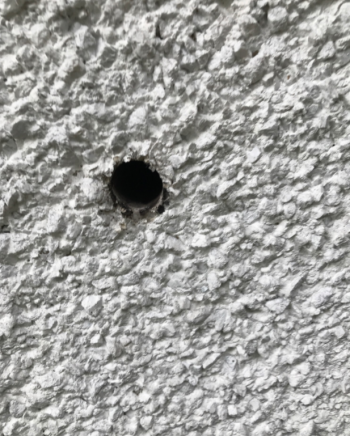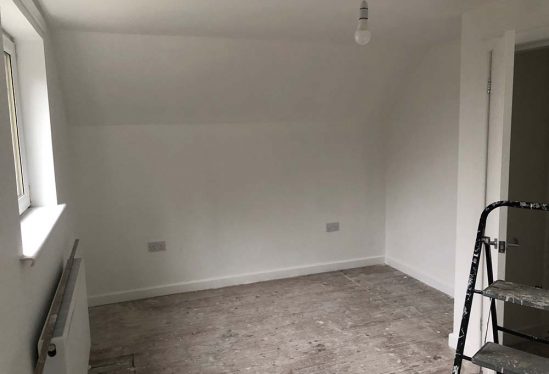Whole house approach
The customer based in South Lanarkshire underwent an initial questionnaire and survey to identify any grant funding that may have been available to improve the energy efficiency of their property. After qualifying for the South Lanarkshire local authority flexibility statement of intent which we in turn supplied grant funding, the customer was then able to have a ‘whole house approach’ taken on the property in which we installed a multitude of energy savings measures including underfloor insulation, room-in-roof insulation, cavity wall insulation and a completely new and full central heating system, providing the customer with a brand-new Esprit Eco 3 boiler and 12 radiators installed throughout the property.
Underfloor Insulation
Prior to Install
The underfloor area of the property was completely void of insulation and required improvements as shown below.


Install
To reduce heat loss and draughts through this space, insulation was installed by our fitting team in accordance with the current PAS 2030:2019 requirements ensuring the work completed was to an exceptional standard.


Cavity Wall Insulation
Following the findings of the survey of the property the cavity wall was deemed to be empty of insulation, meaning a vast amount of heat was being lost in the property due to walls being the main source of heat loss with around 33% of heat escaping through walls.
The lack of insulation is shown below in an image captured through the borescope device used by our surveyor to assess the level of insulation present in the cavity wall.
To reduce the heat loss, our cavity install team drilled holes into the wall and filled the cavity space with PolyPearl bead insulation. These drill holes were then pointed to return the exterior of the property to its previous state and cover the holes
Following the findings of the survey of the property the cavity wall was deemed to be empty of insulation, meaning a vast amount of heat was being lost in the property due to walls being the main source of heat loss with around 33% of heat escaping through walls.
The lack of insulation is shown below in an image captured through the borescope device used by our surveyor to assess the level of insulation present in the cavity wall.
To reduce the heat loss, our cavity install team drilled holes into the wall and filled the cavity space with PolyPearl bead insulation. These drill holes were then pointed to return the exterior of the property to its previous state and cover the holes



pointed hole

Room in Roof Insulation
Installing room in roof insulation involves insulation boarding being fitted over the rafters and over the existing plasterboard walls. Room in roof insulation works by trapping heat within your home to create a blanket effect. This allows you to maintain a warm home more easily without using as much energy to do so, saving you money on your energy bills.
The insulation boards used are usually made from polystyrene or polyurethane which are effective materials for trapping heat. The boards are rigid and can be cut to correct sizes to create a barrier to stop heat escaping. They can then be plastered to create an aesthetic finish for your room and provide a comfortable living space.
This customer’s property transitioned from having a loft space that was not being used effectively, into having a habitable upstairs including bedrooms, bathroom, and lounge spaces, making full use of the area and potential of the property, creating a more desirable home.








First Time Central Heating
Following the findings of the survey of the property the cavity wall was deemed to be empty of insulation, meaning a vast amount of heat was being lost in the property due to walls being the main source of heat loss with around 33% of heat escaping through walls.
The lack of insulation is shown below in an image captured through the borescope device used by our surveyor to assess the level of insulation present in the cavity wall.
To reduce the heat loss, our cavity install team drilled holes into the wall and filled the cavity space with PolyPearl bead insulation. These drill holes were then pointed to return the exterior of the property to its previous state and cover the holes
Following the findings of the survey of the property the cavity wall was deemed to be empty of insulation, meaning a vast amount of heat was being lost in the property due to walls being the main source of heat loss with around 33% of heat escaping through walls.
The lack of insulation is shown below in an image captured through the borescope device used by our surveyor to assess the level of insulation present in the cavity wall.
To reduce the heat loss, our cavity install team drilled holes into the wall and filled the cavity space with PolyPearl bead insulation. These drill holes were then pointed to return the exterior of the property to its previous state and cover the holes




The installation of all the energy savings measures mentioned throughout this case study were achieved through the South Lanarkshire local authority flexibility statement of intent which allowed us to supply the grant funding to cover the costs of the measures installed. The whole house approach ensured the most cost-effective approach was implemented in which the complementary measures work in conjunction with each other, resulting in the customer receiving the maximum benefits in regards to energy savings and efficiency.

